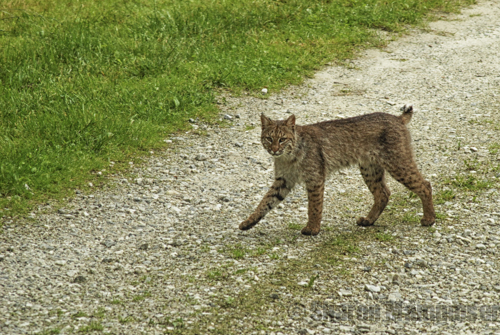I have been lucky enough in my lifetime to have had three bobcat sighting though two of these lasted only seconds. Last year when I was driving on the Blue Ridge Parkway just before sunrise a bobcat bounded out from the woods and darted across the road in front of me. It was a fleeting moment but I felt happy all the same for the whole day, thrilled to have been at that exact place at that exact time. Another time I got to see a bobcat come face to face with a woodchuck–an encounter that lasted for several minutes. (Read about it here)
I know that some people are not thrilled to see a bobcat and in fact, if they see one, they only feel afraid. It seems they are afraid for their safety, imagining that they are at risk of the bobcat attacking and then eating them. This is simply not true! Bobcats are about twice the size of a house cat and have enough fear of humans to run the other way rather than viewing humans as a prey item.
Here are some other things you may not know about the Bobcat:
1. Bobcats are the most widely distributed wild cat in North America. Their range extends north into Canada and south to Mexico. They are related to housecats, lynx, and mountain lions. Bobcats are solitary.
2. Bobcats are crepuscular (most active at dawn and dusk) carnivores. They hunt by stealth, pouncing on their prey from up to 10 feet away. They eat rabbits, squirrels, mice, voles, birds, lizards, snakes, other small animals and fresh carrion. During the winter if food is scarce, they may hunt deer, usually sick, old or injured ones.
3. The male bobcat does not help the female with the raising of the 1-6 kittens born in the spring. Bobcats are polygamous (more than one mate) and do not form a lasting bond.
4. The kittens stay with their mother for 9 to 12 months. They nurse for 60 days and will begin to leave the den and eat solid food at around 4 weeks of age.
5. The life span of a wild bobcat is 10-12 years. As kittens they are preyed on by owls, wolves, coyotes, foxes, and hawks. As adults their main threat is humans.
6. Bobcats can climb trees and swim.
7. A bobcat den is usually made in a cave or other rocky shelter. The female will leave the kittens alone while she goes off to hunt and she will have several den sites available and will move the den regularly.
8. The male bobcat has a much larger range than that of the female. For males that territory is 25-30 square miles and for females, it is 5 square miles. Bobcats are territorial, marking their “home turf” with feces, urine, scent markings and scratches on trees and scrapes (scrapes are piles of debris.)
9. Bobcats are named for their short, 2-9 inch long, “bobbed” tails. Their tails have black fur on the top and white underneath.
 10. Bobcats have long legs and big feet. Their fur color ranges from orangish-brown, to brown to pale gray. They have black spots over their body, which is 26-41 inches long. They can weigh from 11 to 30 pounds.
10. Bobcats have long legs and big feet. Their fur color ranges from orangish-brown, to brown to pale gray. They have black spots over their body, which is 26-41 inches long. They can weigh from 11 to 30 pounds.
References:



1 thought on “Introducing the BOBCAT”
Comments are closed.